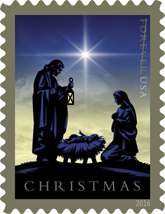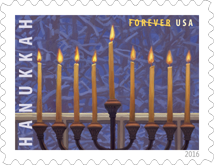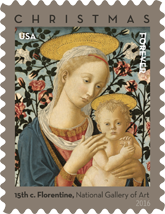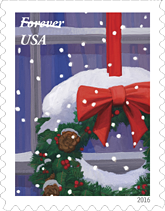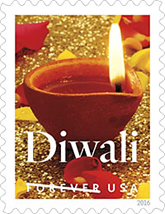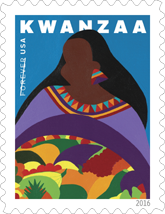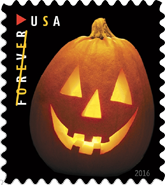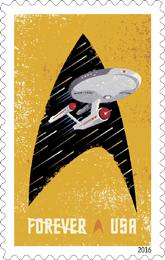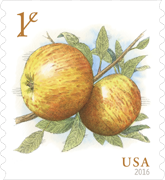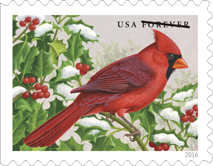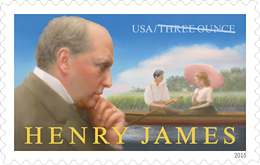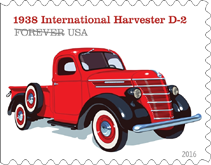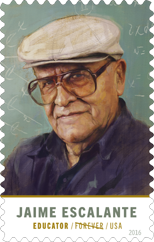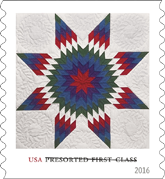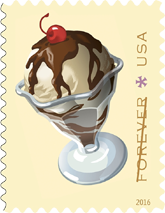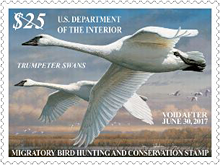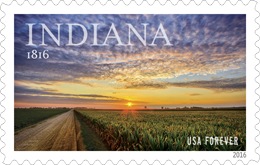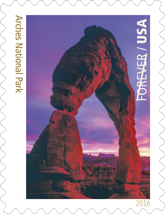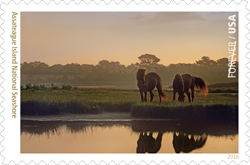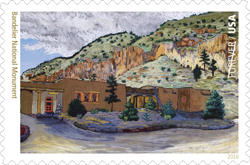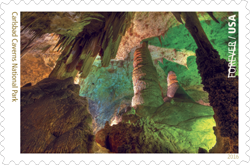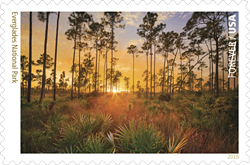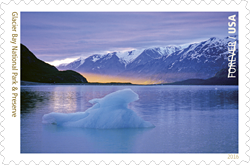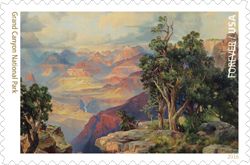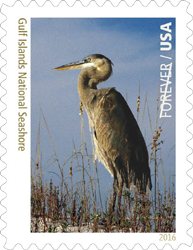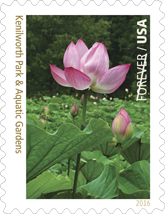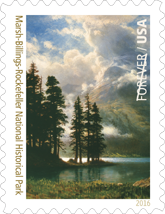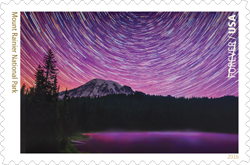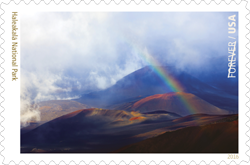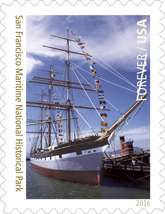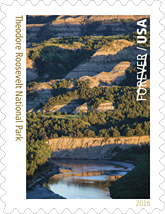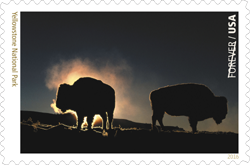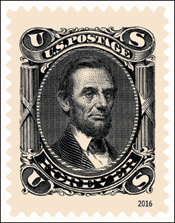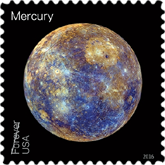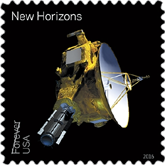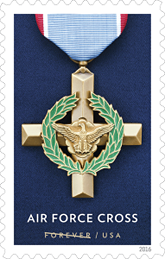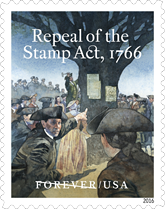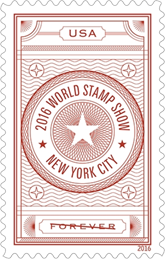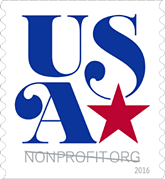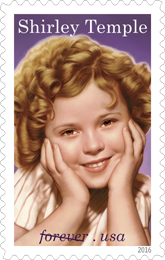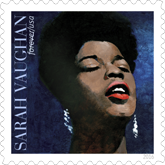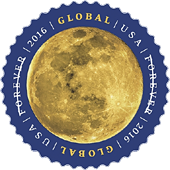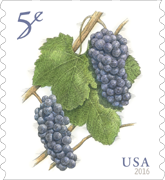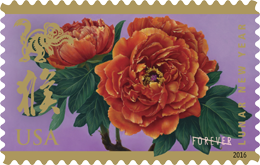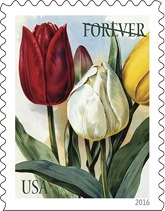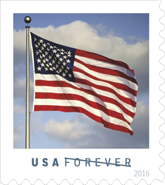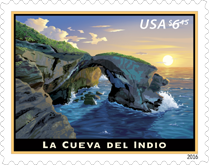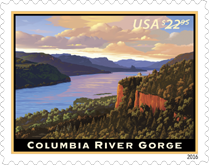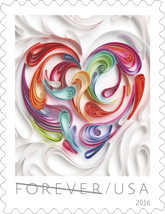 |
Collect the first 176 Years of United States Stamps! Click here to get started!
|
2016 USPS Stamp IssuesLearn everything you need to know about First Day Covers and how to order them by visiting our First Day Covers page including an updated First Day Cover Ordering Calendar, complete with ordering addresses and deadlines. TBD = To Be Determined; PSA = Pressure-sensitive Adhesive; A Forever stamp is always equal in value to the current First-Class Mail one-ounce rate when used on a one-ounce envelope. Stamp Issues:
|
|
Stamp Issues 2016 |
|
|
Nativity Christmas Holiday Forever Stamp The U.S. Postal Service celebrates Christmas with a new stamp featuring a traditional Nativity scene. The Gospel of Luke relates how Mary and Joseph traveled to Bethlehem to register for the census decreed by the Roman emperor, and with no room in the inn, Mary gave birth to Jesus, wrapped him in swaddling cloths, and laid him in a manger. Artists through the centuries have celebrated the Nativity in painting and sculpture. St. Francis of Assisi, a 13th-century Italian preacher, is credited with creating the first crèche. His simple crèche—the manger with an ox and a donkey standing nearby—has been embellished and re-created all over the world. From the 13th century, Nativity dramas, with live animals and people taking part in the story, became an important element in municipal and church celebrations of Christmas. Later, artists and artisans began making figurines to illustrate the Nativity story. They created crèches in styles ranging from small, simple scenes for use in the home to elaborate, life-size Nativity sets designed for churches. |
|
Hanukkah Holiday Forever Stamp The celebration of Hanukkah spans eight nights and days of remembrance and ritual. Hanukkah is the Hebrew word for "dedication." Tradition relates how a miracle took place during the rededication of the Temple in Jerusalem, which had been desecrated by conquering armies. The sacramental oil, thought to be enough for only one day, burned for eight. This miracle of the oil is at the heart of the ritual of the lighting of the hanukiah, a menorah—candelabra—with nine branches, one for each of the eight nights and days of Hanukkah, and the ninth, the shamash or "servant," used to light the other candles. Hanukkah is a joyful time for gatherings of family and friends with feasting, games, and other activities. Children play a game spinning the dreidel, a four-sided top with letters on each side that form an acronym for the Hebrew saying "A great miracle happened there," referring to the miracle of the oil. |
|
Florentine Madonna and Child Holiday Forever Stamp This 2016 Christmas stamp features a detail of Madonna and Child, a 15th-century tempera-on-panel painting in the Widener Collection at the National Gallery of Art in Washington, D.C. The painting is dated to circa 1470, and its anonymous artist is known only as "a Follower of Fra Filippo Lippi and Pesellino." Art historians have long sought to identify the artist who created this painting. Scholars have recently concluded that the painter was heavily influenced by two prominent 15th-century Florentine artists, Fra Filippo Lippi and Francesco Pesellino. The specific painting on this stamp is believed to be based on a Pesellino painting, now in the Musée des Beaux-Arts de Lyon in France, which shows a very similar Madonna and Child against a different background.
|
|
Wonder Woman Forever Stamps First seen in October 1941 to test her appeal at a time when female superheroes were rare, Wonder Woman quickly broke out and headlined her own title by the next year. Subsequent generations came to know her via her hit 1975-79 television series and roles in animated shows and movies, as well as her appearance on the cover of Ms. Magazine #1 in 1972. This past March, Wonder Woman was seen for the first time in a live action motion picture with her introduction in the movie “Batman v Superman: Dawn of Justice.” Now her 75th anniversary is being celebrated on a set of four new stamps that trace her development through four eras: Golden Age (1941–55), Silver Age (1956–72), Bronze Age (1973–86) and Modern Age (1987–present). |
|
Holiday Windows Forever Stamps The 2016 contemporary holiday stamps will highlight the role windows play during the holidays. Portraying four “windows on the holiday world,” the stamps are intended to add a dash of winter bliss to letters and cards during the year's coldest months. Two of the designs show views from the inside looking out: a single burning candle sits on a sill and a simple star ornament hangs from a hook attached to the window sash, out of sight. Two other designs show views from the outside looking in: a brightly lit Christmas tree contrasts with the snowy shrubs on the other side of the glass and a snow-covered wreath hangs in front of frosted window panes. |
|
Festival of Diwali Forever Stamp The joyous Hindu festival of Diwali is the latest religious celebration to be recognized by the U.S. Postal Service. Diwali celebrates the triumph of good over evil. Diwali is a shortened version of the Sanskrit word Deepavali, which roughly translates as "a necklace of lights." On the Hindu calendar, it falls on the eve of, or on, the new moon that occurs between mid-October and mid-November. In 2016, the main day of the festival will be celebrated October 29 for South Indians and October 30 for North Indians. Diwali also marks the new year for people in Gujarat and a few other states of India. Before the festival, many Hindus traditionally go shopping, clean their homes, open their doors and windows, create intricate rangoli—a vibrant floor pattern traditionally made from materials such as rice powder, colored sand and flower petals—and light diyas with hopes that Lakshmi, the goddess of wealth and prosperity, will visit. In some regions of India, people play games, just as Hindu lore says that the god Shiva did. On the festive main day of the holiday, families pray for Lakshmi, dress up in their best clothes, enjoy lavish feasts and sweets, exchange gifts and light fireworks. The stamp design is a photograph featuring a traditional lit diya oil lamp, sitting on a gold background. Diya lamps are usually made from clay with cotton wicks dipped in a clarified butter known as "ghee" or in vegetable oils. |
|
Kwanzaa Holiday Forever Stamp Kwanzaa is a festive, non-religious holiday that takes place over seven days, from December 26 to January 1, and together family, community, and culture for many African Americans. December 26, 2016, marks the 50th anniversary of this widely celebrated holiday. Created in 1966, Kwanzaa draws on African traditions, deriving its name from the phrase "first fruits" in Swahili, a widely spoken African language. With its origins in first harvest celebrations that occurred across the African continent in ancient and modern times, Kwanzaa synthesizes and reinvents these tribal traditions as a contemporary celebration of African-American culture. The holiday honors seven principles—unity, self-determination, collective work and responsibility, cooperative economics, purpose, creativity, and faith—based on values prevalent in many African cultures. Each day of Kwanzaa is dedicated to the focus of one of these seven principles. The three primary colors of Kwanzaa—red, black, and green—also hold special significance for the holiday and its participants. Red indicates the blood shed during struggles endured by those of African descent, black symbolizes the African people, and green signifies growth and renewal. Each year African Americans gather with friends and family around a table set with the mkeka —a straw mat symbolizing the history of African Americans. They light seven candles known as the mishumaa saba, each representing one of the founding principles, and share in a feast that celebrates their shared heritage. |
|
Jack-O'-Lanterns Forever Stamps Jack-o'-lanterns have been symbols of Halloween in the U.S. since the late 19th century. Based on legends tracing back to Europe, a man named Jack tricks the Devil in unscrupulous ways that prevent Jack from going to Heaven but which also infuriates the Devil, who refuses to carry Jack's soul to hell. With nowhere to go after he dies, Jack forever wanders the earth with a lantern made from a hollowed-out turnip lit by an ember from the fires of hell, a fate that earns him the name Jack of the Lantern. In North America, native pumpkins proved to be a more fitting medium for carving. Although Halloween itself is now largely a non-religious celebration, it grew out of All Hallows' Eve, which is the night before All Saints' Day, an early Christian observance still widely celebrated today. By the 1500s, All Hallows' Eve—a name eventually shortened to Halloween—was celebrated in the British Isles on October 31 amid bonfires, costumes, and revelry. Brought to North America by immigrants from Ireland and Scotland, Halloween became a distinctively American celebration. After World War II, trick-or-treating gave Halloween a youthful emphasis, but since the 1970s adults have joined in once again. The first day site, Anoka is known as “the Halloween Capital of the World” because it hosted one of the first Halloween parades in 1920, and still holds several Halloween parades. |
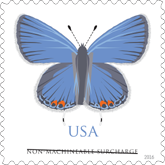 |
Butterfly "Non-Machineable Surcharge" Stamp This "Non-Machineable Surcharge" stamp is intended for use on irregularly sized envelopes, such as square greeting cards, invitations and announcements, even if they weigh less than one ounce. The stamp was developed in collaboration with the greeting card industry specifically for oversized or square envelopes. These envelopes cannot pass through the automated Postal Service processing system and have to be hand-cancelled. Like a Forever stamp, this issue will always be valid for the rate printed on it, 68¢ at the time of issue. The design is a highly stylized, simplified image of a male Eastern Tailed-Blue butterfly, rather than an exact replica. It is named for the iridescent blue color of its upper wing surface and for the short, thread-like tail on each hind wing. Each year sees two or more generations, the first being the most colorful.
|
|
Star Trek Forever Stamps Celebrating the television show Star Trek on the 50th anniversary of its premiere, these four new stamps showcase four digital illustrations inspired by elements of the classic program: the Starship Enterprise inside the outline of a Starfleet insignia; the silhouette of a crewman in a transporter; the silhouette of the Enterprise from above; the Enterprise inside the outline of the Vulcan salute, Spock's iconic hand gesture. |
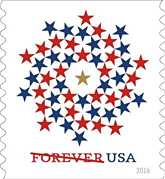 |
Patriotic Spiral Stars Forever Stamp Without declaring it directly, in announcing this new stamp, the Postal People addressed the growing divisions in America, with this description: "This festive and energetic stamp design features 50 blue and red stars spiraling around a central gold star on a white background. The idea for the design was to illustrate a community of stars protectively orbiting a central star that in an abstract sense stands for our nation's steadfast idealism and hope for a more perfect union." The stamp is available in two formats, with two different First Day of Issue locations: Booklets of 10 for consumers, issued in Falls Church, VA; and self-adhesive coils of 10,000 for businesses, issued in Kansas City, MO. While the Postal People say that the coils of 10,000 will be available at post offices, collectors seeking small strips must order them via the Philatelic Sales website or phone Fulfillment Center. |
|
Apples - 1-Cent Stamp This new one-cent definitive stamp features two Albemarle Pippin Apples on a branch surrounded by leaves. The Newtown Pippin is an American apple originated in the late 17th or early 18th century. U.S. presidents George Washington and Thomas Jefferson both grew the Newtown in Virginia, where it acquired the alternate name Albemarle Pippin after Albemarle County, Virginia. John Burgoyne of Barnstable, Mass. designed the Albemarle Pippin Apples stamp. |
|
Songbirds in the Snow Forever Stamps Following the many World Stamp Show issues, the USPS apparently ran out of stamps to release at major stamp shows. This will explain the August release of four Songbirds in Snow stamps. The stamps picture the Golden-crowned Kinglet, the Cedar Waxwing, the Red-breasted Nuthatch, and the Northern Cardinal. The Postal People tell us, "The sight of birds sitting on a snowy tree branch and the sound of their songs and calls bring joy in the depth of winter." Though many birds migrate to warmer climes before the snow falls, some hardy birds have ways to cope with the cold. Fluffing their feathers creates an insulating layer of air, and their winter plumage can contain up to 30 percent more feathers than in summer. Many birds are able to slow their metabolism, lower their body temperatures, or even reduce their heart rate to help them conserve energy.
|
|
Pets Forever Stamps This issuance recognizes America's love of pets. The stamp art for the Pets booklet features 20 existing photographs. Each photograph represents an animal from these groups: puppies, betta fish, iguanas, hamsters, goldfish, parrots, guinea pigs, tortoises, rabbits, kittens, corn snakes, mice, hermit crabs, chinchillas, gerbils, dogs, parakeets, horses, cats, and geckos. |
|
Henry James The 31st stamp in the Literary Arts series honors Henry James (1843– 1916). In novels and stories that often explored the complex interplay between Americans and Europeans, James sought to portray the intricacies of society and the inner lives of his characters with a realism that earned him a reputation as one of the greatest writers America has ever produced. The stamp art is an original painting created for the stamp by Kate Simmons. On the left is a portrait of Henry James based on a 1906 photograph by Alvin Coburn. On the right, behind James, is a vignette showing a man and a woman in a small boat, an artistic interpretation of the climactic scene from James' 1903 novel The Ambassadors. Continue reading "Literary Arts Series Adds Henry James" [PDF Document] |
|
Pickup Trucks Forever Stamps These four new stamps feature these rugged and reliable work vehicles: The 1938 International Harvester D-2, with its barrel-shaped grill and styling that mirrored the look of luxury automobiles of the era. The 1953 Chevrolet, which featured large windshields that provided drivers with excellent visibility, a distinctive curvy grill that bulged in the middle, and a six-cylinder engine. The 1948 Ford F-1, which included features like the roomy "Million Dollar Cab," a sharp horizontal five-bar grill, and a six- or eight- cylinder engine. The 1965 Ford F-100, which had a grill that featured 18 small rectangular openings. It also featured what Ford dubbed "Twin-I-Beam" independent front suspension. |
|
Jaime Escalante Forever Stamp Born to two schoolteachers in La Paz, Bolivia, Jaime Escalante migrated to the United States in 1963, and in 1974 obtained a teaching position at Garfield High in East L.A., a school with high dropout rates and gang violence. He was assigned to teach basic math to students who appeared to be undisciplined and uninterested. Using a variety of unusual methods—bonding with students over their shared love of the Lakers basketball team, dressing as a chef and using cooking as a way to teach percentages, competing against his students in sporting events and teasing them about their habits and tastes—he motivated his students to attend class and to learn. In 1988 the story of the dedicated teacher and his highly motivated students was told in the movie, Stand and Deliver , and the book Escalante: The Best Teacher in America . In 1998, he retired from teaching in the U.S., and a year later was inducted into the National Teachers Hall of Fame. He died on March 30, 2010. |
|
Star Quilts Presorted First-Class Stamp With names like Blazing Star, Touching Stars, and Starburst, stars are one of the most popular design motifs for American quilters. These stamps feature two versions of one of those favorites, the Lone Star pattern. Each stamp shows a detail from a photograph of one of the two quilts highlighting the intricate work involved in creating the star design. The quilt top is created by stitching together many small diamond shaped pieces of fabric. The quilts featured in the stamp art were made by Amish quilt makers. |
|
Soda Fountain Favorites Forever Stamps The U.S. Postal Service celebrates soda fountain favorites with five examples of the cool, fizzy confections: a double-scoop ice cream cone, an egg cream, a banana split, a root beer float, and a hot fudge sundae. During the 17th and 18th centuries, scientists and physicians touted the curative properties of mineral water. As the 19th century progressed, thousands of soda fountains sprang up inside American restaurants, candy shops, department stores and pharmacies. By the late 1800s, Americans had long since begun drinking carbonated beverages for their pleasant taste, rather than their supposed health benefits. |
|
$25 Federal Duck Stamp (not a postage stamp) The 2016-2017 Duck stamp features Joseph Hautman's acrylic painting of a pair of trumpeter swans. This is Hautman's fifth Federal Duck Stamp contest win. The new stamp is valid from July 1, 2016 through June 30, 2017. In addition to being required by waterfowl hunters age 16 and older, it also is popular with conservationists and collectors. Duck stamps are not postage stamps; they are conservation revenue stamps. The Fish and Wildlife Service (FWS) produces the Federal Duck Stamp, which raises about $25 million each year. FWS states that 98 percent of the purchase price goes directly to help acquire and protect wetland habitat and purchase conservation easements for the National Wildlife Refuge System. |
|
Eid Holiday Greetings Forever Stamp This stamp commemorates the two most important festivals—or eids—in the Islamic calendar: Eid al-Fitr and Eid al-Adha. The gold-colored calligraphy on the stamp was created by world-renowned calligrapher Mohamed Zakariya. It reads Eidukum mubarak, "May your Eid be bountiful (or blessed)." The calligraphy on previous Eid stamps issued by the USPS read Eid mubarak, "may the religious holiday be blessed." To the right of the script, a stylized olive branch rendered in gold carries connotations of abundance, family, hospitality, and peace. |
|
Indiana Statehood Forever Stamp This stamp celebrates the 200th anniversary of Indiana's statehood. Known as the Hoosier State, Indiana became the 19th state of the Union on December 11, 1816. According to the USPS, "Indiana has often been considered the heartland of America…Its fertile soil has long made it ideal for crops like corn, which remains a staple of Indiana's agricultural economy." For this reason, the stamp features a photograph of the expansive cornfields near Milford, Indiana, at sunset. The state also is known for the Indianapolis 500 and its devotion to basketball. |
|
Colorful Celebrations This double sided booklet of 20 stamps contains 10 different designs that are meant to be reminiscent of the Mexican craft of "papel picado." This translates to "pierced paper," although the stamps themselves do not have the paper pierced. According to the Postal People, the intricate designs on the stamps, which show birds, flowers and symbols, "do not strictly follow the thematic traditions of the Mexican art form, but instead are whimsical, colorful vignettes in the style of" papel picado. This art style is used for many festivities by Mexican-Americans, and it is expected that other mailers will want to use these stamps for any festive occasion. |
See below for |
National Parks Forever Stamps This set of 16 stamps celebrates the Centennial of the National Park Service. Because of the popularity or our National Parks, each stamp, previewed by the U.S. Postal Service one at a time, is treated separately here. |
|
Acadia National Park, Bar Harbor, Maine The Acadia stamp depicts the Bass Harbor Head Light. People have been drawn to the rugged coast of Maine throughout history. Awed by its beauty and diversity, early 20th-century visionaries donated the land that became Acadia National Park. The park is home to many plants and animals, and Cadillac Mountain, the tallest mountain on the U.S. Atlantic coast. Today visitors go to Acadia to hike granite peaks, bike historic carriage roads, or relax and enjoy the scenery. Acadia National Park was featured on the 7¢ stamp in the 1934 National Parks set and on a 2001 Scenic American Landscapes 60¢ Airmail stamp. Click to see previous issues of Acadia National Park. |
|
Arches National Park, Moab, Utah The stamp image is a photograph by Tom Till of Moab, Utah, and represents the iconic Delicate Arch. Delicate Arch is just one of more than 2,000 stone arches in the park, which is located in eastern Utah and contains the greatest density of natural arches in the world. The park is a landscape of contrasting colors, landforms and textures with thousands of natural stone arches, hundreds of soaring pinnacles, massive fins and giant balanced rocks. Delicate Arch was featured on the 1996 stamp commemorating the Centennial of Utah Statehood. Zion National Park, in southwestern Utah was featured on the 8¢ 1934 National Parks stamp and on a 2009 Scenic American Landscapes Airmail stamp. Click to see a previous issue of Arches National Park. |
|
Assateague Island National Seashore, Maryland & Virginia Wild horses of Maryland's and Virginia's Assateague Island National Seashore are featured on this stamp in the 2016 National Parks set. Bands of wild horses roam among the plants and native animals that have adapted to the sandy beaches, salt marshes, maritime forests and coastal bays that make up this area. They are split into two main herds, separated on Assateague by a fence at the Virginia /Maryland state line. The Virginia herd is also known as Chincoteagues because they live within Chincoteague National Wildlife Refuge. The annual Chincoteague Pony Swim and auction draws thousands of spectators each July. This is the first time Assateague has been featured on a U.S. stamp. |
|
Bandelier National Monument, New Mexico A 1930s pastel-on-paper painting by Helmuth Naumer (1907–1990) depicting the Pueblo Revival-style visitor center at Bandelier National Monument in Frijoles Canyon near Los Alamos is the central feature on the Bandelier National Monument stamp. Bandelier National Monument protects over 33,000 acres of rugged, beautiful canyon and mesa country as well as evidence of a human presence there going back more than 11,000 years. Petroglyphs, dwellings carved into the soft rock cliffs, and standing masonry walls pay tribute to the early days of a culture that still survives in the surrounding communities This is the first time Bandelier has been featured on a U.S. stamp.
|
|
Carlsbad Caverns National Park, New Mexico The Carlsbad Caverns stamp image is a photograph of the interior of the caverns by Richard McGuire. High ancient sea ledges, deep rocky canyons, flowering cacti and desert wildlife are all treasures above and below the Chihuahuan Desert ground. Carlsbad Cavern is one of more than 300 limestone caves in a fossil reef laid down by an inland sea 240 million to 280 million years ago. This is the first time Carlsbad Caverns has been featured on a U.S. stamp. |
|
Everglades National Park, Florida Spanning the south Florida peninsula from Miami to Naples and south to the Florida Keys, Everglades National Park's 1.5 million acres of sawgrass prairies, tropical hardwood hammocks, pine rocklands, mangrove forests and marine and estuarine waters provide habitat for a wildlife spectacle like no other. Crocodiles, alligators, manatees, flamingos, herons and turtles are just a small sampling of wildlife that can be seen there. The park was established in 1934 to protect the vanishing Everglades from the inroads of new homes and businesses across south Florida. It was dedicated as a National Park in December 1947, the first such Park to be established to protect an ecosystem, as opposed to geographic features. Click here to see the 1947 Dedication of Everglades National Park stamp. |
|
Glacier Bay National Park and Preserve, Alaska Covering 3.3 million acres of rugged mountains, dynamic glaciers, temperate forests, wild coastlines and deep sheltered fjords, Glacier Bay National Park and Preserve is a highlight of Alaska's Inside Passage and part of a 25-million acre World Heritage Site—one of the world's largest international protected areas. With no roads to the park, it is still enjoyed by over 400,000 visitors a year, primarily by cruise ships or air, but also by white-water rafting. Glacier Bay is not to be confused with Glacier National Park, which is located in Montana and has been pictured before on United States stamps. |
|
Grand Canyon National Park, Arizona For the sixth time, the Grand Canyon is featured on a United States postage stamp, in this case as part of the National Parks pane of 16 different stamps. The latest Grand Canyon stamp image is a detail of "The Grand Canyon of Arizona, from Hermit Rim Road," by artist Thomas Moran (1837–1926). For more than five million years the Colorado River and its tributaries has been cutting its path, exposing nearly two billion years of geological history. It continues today to deepen and widen the Grand Canyon, making it one of the seven natural Wonders of the World, with a unique combination of geologic color and erosional forms that are 277 river miles long, up to 18 miles wide and one mile deep. Click to see Grand Canyon on prior United States Stamps. |
|
Gulf Islands National Seashore, Florida and Mississippi The heron, a long-legged water bird with a wingspan that can exceed six feet, is featured on the Gulf Islands National Seashore on this National Parks stamp. The Gulf Islands natural and historic resources include mainland areas and parts of seven islands along the Gulf of Mexico barrier islands of Florida and Mississippi. While most of this National Park is made up of submerged lands populated by marine life, there also are marshes with diverse plants and animals, and oak forests that contain resident and migrating birds. The seashore section was authorized in 1971 and the wilderness area was added in 1978. |
|
Kenilworth Park & Aquatic Gardens, D.C. A water lily with a bloom the size of a basketball is featured on the National Parks stamp for Washington, D.C.'s Kenilworth Park & Aquatic Gardens. The water lilies are a sample of the hidden treasures tucked away in this 700-acre park surrounded by urban neighborhoods, on the banks of the Anacostia River and just west of the Baltimore Washington Parkway. When the land that is now Kenilworth Aquatic Gardens was purchased by Civil War veteran Walter B. Shaw in the 1880s, he had wild waterlilies native to his home state of Maine brought in, followed by other plants, after which he started a commercial attraction as the Shaw Lily Ponds. Years after he died, when the Army Corps of Engineers was called in to dredge the Anacostia River and the gardens were in danger of being destroyed, in 1938 Congress authorized the purchase of the gardens to create the park. |
|
Marsh-Billings-Rockefeller National Historical Park, Woodstock, Vermont An iconic Hudson River School of Art landscape painting linked to the Conservation Movement that supported interest in creating the National Park system appears on the stamp for the Marsh-Billings-Rockefeller National Historical Park. The stamp image is a detail of Bierstadt's oil-on-canvas painting “Scenery in the Grand Tetons.” The name of the park honors three individuals and their families who played important roles in American conservation history: George Perkins Marsh (1801-1882), Frederick Billings (1823-1890) and Laurance S. Rockefeller (1910-2004). During the 19th century, the artists of a young America searched for a new world view and found it in the very landscapes around them. Inspired by the stunning natural beauty from across the United States, the loose-knit Hudson River School of painters flourished from the mid-1830s to the mid-1870s and gave America its first major school of art. Americans who bought their paintings and admired them on the walls of their city homes came to believe that those scenes should be preserved for future generations, not just painted or photographed. Click here for additional information on this issue, the complete "Scenery in the Grand Tetons" painting, and additional Bierstadt images. [PDF Document] |
|
Mount Rainier National Park, Washington A photograph of something you will most likely not see there is used for the new National Parks Mount Rainier stamp. It is a design created from 200 images using time lapse photography during an aurora between 2 a.m. and 4 a.m. The photos were taken by photographer Matt Dieterich of Pittsburgh, Pa. Ascending to 14,410 feet above sea level, Mount Rainier is an active volcano, though as of 2010 there was no evidence of an imminent eruption. It is the most glaciated peak in the 48 contiguous United States, spawning six major rivers. As a result, if it did erupt, the lahars carried by the melting ice would be a threat to the entire Puyallup River valley. Mount Rainier was established as a National Park in 1900, even before the National Park Service. The new stamp is a different take on the Mount Rainier that has been seen on previous United States stamps. Click here to see those previous issues. |
|
Haleakalā National Park Haleakalā National Park is located on the Hawaiian island of Maui. The park covers an area of 33,265 acres of which 19,270 acres is a wilderness area. The park features the dormant Haleakalā Volcano. The summit area includes the huge Haleakalā Crater, two miles wide and 2,600 feet deep. Two main trails lead into the crater, and hikers can stay in one of three cabins in the crater. The name Haleakalā is Hawaiian for "house of the sun." According to a local legend, the semigod Maui imprisoned the sun there in order to lengthen the day. The spectacular sunrises and sunsets are another of the attractions. The stamp is based on a photograph by Kevin Ebi, capturing a rainbow created by the late afternoon sun shining through during a brief letup in a heavy rain storm. |
|
San Francisco Maritime National Historic Park, California A photograph of an iconic three-masted sailing ship is featured on the stamp for the San Francisco Maritime Historic National Park. The park includes a fleet of historic vessels, a visitor center, a maritime museum, and a library/research facility. It is sometimes referred to as the San Francisco Maritime Museum, its name before 1978, when the collections were acquired by the National Park Service. Authorized as a National Park in 1988, it is located near Fisherman's Wharf, and offers the sights, sounds, smells and stories of Pacific Coast maritime history. The stamp image is from a photograph of the 1886 square-rigger, Balclutha, by Tim Campbell of San Francisco. Just visible to the right of the deep waterman/salmon packet sailing vessel is the 1907 steam tugboat Hercules. |
|
Theodore Roosevelt National Park, North Dakota According to the National Park Service, when Theodore Roosevelt came to Dakota Territory to hunt bison in 1883, the rugged landscape and strenuous life he experienced there would help shape a conservation policy from which we still benefit today. Theodore Roosevelt National Park contains several sites of historical significance, each relating to the era of cattle ranching in the late 1800s. Most significant is Theodore Roosevelt's Elkhorn Ranch site, where he spent the bulk of his time and where he developed many of his conservation ideas. Following Roosevelt's death in 1919, the Little Missouri Badlands were explored to determine possible park sites. During the Depression, Civilian Conservation Corps camps were established in both of the future park units, and they developed roads and other structures in use today. In 1946 the area was transferred to the United States Fish and Wildlife Service as the Theodore Roosevelt National Wildlife Refuge, and in 1947 President Truman established the Theodore Roosevelt National Memorial Park. A photograph of the Little Missouri River winding through the Badlands of North Dakota is featured on the stamp. The Little Missouri River flows through all three units of the 110-square-mile park, and the Maah Daah Hey Trail connects all three units. The park is home to a wide variety of Great Plains wildlife including bison, mountain lion, feral horses, elk, bighorn sheep, white-tailed deer and mule deer, prairie dogs, and at least 186 species of birds including golden eagles, sharp-tailed grouse, and wild turkeys. The entire park has been surrounded with a 7-foot tall woven wire fence to keep bison and feral horses inside the park and commercial livestock out. Other animals are able to pass over, under, or through the fence in specific locations provided for that purpose. |
|
Yellowstone National Park, ID, MT and WY A photograph of two bison silhouetted in Yellowstone National Park's winter morning sun is used for the Yellowstone stamp in the set of 16 National Wildlife Service Centennial set. Yellowstone, believed to be the first National Park in the world, was established on March 1, 1872. Covering almost 3,500 square miles, Yellowstone contains canyons, rivers, mountain ranges and lakes, including Yellowstone Lake, one of the largest high-elevation lakes in North America. The park is home to hundreds of species of mammals, birds, fish, reptiles and plant life. Grizzly bears, wolves, and free-ranging herds of bison and elk live in the park. The Park is located over the largest supervolcano on the continent, a feature that has resulted in half of the world's geothermal features being located in Yellowstone. One of these features is its Old Faithful geyser, which has been featured on two United States stamps. Click here to see the 1934 National Parks stamp and the 1972 stamp celebrating the Centennial of Yellowstone as the first National Park. |
|
Classics Reproductions Issued in celebration of the long history of U.S. postage stamps, this souvenir sheet features new versions of six of America's earliest stamps, re-issued as Forever stamps to make them easily distinguishable from the mid-19th-century originals. The selvage is composed of cancellations and script from envelopes contemporaneous with the stamps on a buff-colored background with a textured look intended to evoke stationery of the period. The inner border is meant to be reminiscent of a star-spangled patriotic bunting. The great news for used stamp collectors is that these are the first U.S. pressure sensitive adhesive stamps on which the gum is water soluble so that they can be soaked and saved in the same manner as water-activated gum stamps. Continue reading "Early Classics Stage a Comeback" [PDF Document] |
|
Views of Our Planets This issue showcases some of the more visually compelling full-disk images of the planets obtained during this era of space exploration. All eight planets are shown; Pluto, no longer a "planet". is not. Some stamps show the planet's "true" color—what we might see with our own eyes if traveling through space. Others use colors to represent and visualize certain features of a planet based on imaging data. Still others use the near-infrared spectrum to show things that cannot be seen by the human eye in visible light. The verso text explains the images and identifies the spacecrafts and telescopes that helped obtain them. |
|
Pluto Explored This issue recognizes the history-making first reconnaissance of Pluto in 2015 by NASA's New Horizons mission. This souvenir sheet contains two new stamps. The first stamp shows an artist's rendering of the New Horizons spacecraft. The second shows the spacecraft's striking image of Pluto near its closest approach. The view, which is color-enhanced to highlight surface texture and composition, is a composite of four images from New Horizons' Long Range Reconnaissance Imager, combined with color data from the imaging instrument Ralph. It clearly reveals the now-famous heart-shaped feature. |
|
Service Cross Medals Forever Stamps This issue continues a Postal Service tradition of honoring the bravery and achievements of members of the U.S. Armed Forces. Previous issues having depicted the Medal of Honor, these new stamps honor recipients of the Distinguished Service Cross (Army), Navy Cross (Navy and Marine Corps), Air Force Cross, and Coast Guard Cross. These decorations are awarded for acts of extraordinary heroism in which an individual braved enemy fire, made bold decisions, and took selfless actions to rescue or protect fellow service members. Continue reading "USPS Recognizes Service Cross Recipients" [PDF Document] |
|
Repeal of the Stamp Act, 1766 Forever Stamp This issue commemorates the 250th anniversary of the repeal of the Stamp Act, British legislation that galvanized and united the American colonies and set them on a path toward revolution. The act required payment of a tax on a wide array of paper materials, such as newspapers, pamphlets, legal documents, licenses, mortgages, contracts, and bills of sale. A stamp would be embossed on these papers to indicate payment. The stamp art depicts a crowd gathered around a "liberty tree" to celebrate the repeal of the Stamp Act. The selvage area displays a proof print of a one-penny revenue stamp and includes a famous slogan from the era: “Taxation without representation is tyranny,” a theme that has once again become popular with some groups of citizens.
|
|
World Stamp Show-NY 2016 commemorative sheets Held approximately every ten years, the first International Philatelic Exhibition to be hosted by the United States was held in New York CIty in 1913. This Souvenir Folio commemorates the 11th International stamp show to be held in the U.S., from May 28 to June 4, 2016, at the Jacob Javits Convention Center in New York City. The designs are based on the two stamps issued in 2015 to announce the upcoming World Stamp Show-NY 2016 and inviting philatelists and amateur stamp enthusiasts to attend. |
|
USA Non-profit Nondenominated (5¢) Stamp This new nondenominated, nonprofit-price stamp, showcases the letters "USA" in a stamp that the Postal Service describes as "a patriotic design with full letterforms and flourishes [that] is a confident, playful, and celebratory treatment of one of our most familiar abbreviations." The stamp is intended for use by high volume non-profit mailers. Studies have shown that mail is more likely to be opened when the envelope bears a stamp rather than a printed indicia. Mailers apply the stamp to each mailing piece, calculate the total postage due and pay the Postal Service a lump-sum for the actual postage in excess of 5¢ per piece. |
|
Shirley Temple - Legends of Hollywood Forever Stamp With the 20th stamp in the Legends of Hollywood series, the Postal Service honors actress and diplomat Shirley Temple Black. As a child, Temple was the most famous film star in the world. She began dance lessons when she was just three years old, and by age five she was under contract to Fox Film Corporation. Her song, "On the Good Ship Lollipop," is a classic, and the Shirley Temple doll remains one of the most collectible dolls ever made. As an adult, Black had a distinguished career in diplomacy, serving as a delegate to the United Nations, U.S. Ambassador to Ghana and Czechoslovakia, and U.S. Chief of Protocol. The stamp art features a painting based on a 1935 still image from "Curly Top," one of her iconic movie roles. The selvage features a publicity photo from the 1933 short film "Managed Money". |
|
Sarah Vaughan - Music Icon Forever Stamp Born March 27, 1924, Sarah Vaughan was one of America's greatest singers, successful in both jazz and pop, with a talent for improvisation and skillful phrasing and a voice that ranged over several octaves. The stamp art is an oil painting of Vaughan in performance based on a 1955 photograph by Hugh Bell. The cover side of the pane features a larger version of the stamp art and a list of some of "The Divine One's" popular songs. The stamp will be issued at the Sarah Vaughan Concert Hall. |
|
The Moon Global Forever Stamp This round stamp features a detailed photograph of a full moon as it rose over Fort Lauderdale, Florida. Issued at the $1.20 price, the stamp can be used to mail a one-ounce letter to any country to which First-Class Mail International service is available. The moon, the Earth's only natural satellite. has long had considerable impact on mankind. Its gravitational pull creates ocean tides and affects our planet's motions. A full moon occurs approximately every 29.5 days when the moon is opposite the sun, with Earth between the two. Since the rotation and orbit periods of the moon are the same, the same part of the moon is always seen from Earth. |
|
Grapes - 5-Cent Stamp This new five-cent definitive stamp features two clusters of deep-purple Pinot noir grapes growing on vines among several green leaves. Identified as a French wine grape, it is now grown in other regions including Oregon and California in the United States. Translated from the French, "pinot" is "pine", for the pine-cone shaped clusters in which the grapes grow, and "noir" is "black". John Burgoyne of Barnstable, Mass. designed the Grapes stamp. |
|
Year of the Monkey - Lunar New Year Forever Stamp New York artist Kim Mak once again brings us a design that features a traditional form of Lunar New Year celebration. The stamp art features two bright reddish-orange peonies against a purple background. Peonies symbolize wealth and honor in Chinese culture and often decorate the sides of the traditional drums played during the holiday festivities. The stamp design incorporates two elements from the previous series of Lunar New Year stamps: the intricate cut-paper design of a monkey and the Chinese character for "monkey," drawn in grass-style calligraphy. |
|
Richard Allen - Black Heritage Forever Stamp Born February 14, 1760, Allen was a preacher, activist, and civic leader. This stamp coincides with the 200th anniversary of Allen's founding of the African Methodist Episcopal Church, one of the most important institutions in African-American life, and his election as its first bishop. The stamp art is a portrait of Allen, a detail from an 1876 print titled "Bishops of the A.M.E. Church." Featuring Allen in the center surrounded by ten other bishops and six historical vignettes, the full print is from the collection of the Library Company of Philadelphia. The stamp will be issued at the Mother Bethel A.M.E. Church. Click for article: Church Founder Richard Allen Honored
|
|
Botanical Art Forever Stamps This issue continues the Postal Service's tradition of floral-themed stamps that are popular with mailers. The stamp art features ten different floral designs, each a detail of an illustration that appeared in an American nursery catalog between 1891 and 1912. The design details are courtesy of The New York Botanical Garden, whose Nursery and Seed Catalog Collection is one of the largest and most important such collections in the U.S. Click for article: Nursery Catalog Art Flowers on New Issue |
|
U.S. Flag Forever Stamp The American flag has long symbolized the strength and spirit of the United States, and many Americans like to use these stamps on their outgoing mail and see them on incoming mail. The Postal Service, therefore, always tries to have Flag stamps available to individual and volume mailers. This latest U.S. Flag First-Class Mail Forever stamp features a detail of a photograph of a flag waving against the background of a blue sky. |
|
Pears - 10-Cent Stamp This new ten-cent definitive stamp features two red pears on a white background. The two most common red pears grown in the United States are the red Anjou, similar to green Anjous in all respects other than color; and red Bartlett pears, referred to as "Summer Pears" for the time of year in which they are harvested. John Burgoyne of Barnstable, Mass. designed the Pears stamp. |
|
La Cueva del Indio Priority Mail Stamp This new Priority Mail stamp features one of Puerto Rico's many magical and mysterious caves. The stamp art depicts a sunset view of La Cueva del Indio, or the Cave of the Indian, which is located near Arecibo on Puerto Rico's north coast. The cave gets its name from the great number of engravings, known as petroglyphs, found on its walls. A $6.45 Priority Mail Envelope with the same design also was issued January 17 in Washington, D.C. |
|
Columbia River Gorge Express Stamp This new Priority Mail Express stamp depicts the grandeur of the Columbia River Gorge. Approximately 80 miles long and up to 4,000 feet deep, the gorge runs along the Columbia River, which forms part of the border between Oregon and Washington. The stamp art captures the beauty of the Columbia River as it winds its way through the steep cliffs of the Cascade Mountain Range. The historic Vista House, sits atop Crown Point, overlooking the river 725 feet below, seen on the stamp in the setting sun. |
|
Quilled Paper Heart - Love Forever Stamp The stamp features a heart that was created using the ancient art of quilling. Quilling involves rolling and shaping narrow strips of paper, laying them on their edges, and gluing them in place to form intricate designs. The heart shape in the center of the stamp art is made from paper strips of many colors and is surrounded by white paper swirls on a white background. Click for article: Quilling Art on 2016 Love Stamp |
| Stamp images provided by the United States Postal Service. Copyright © 2016 USPS. All Rights Reserved. |
|
| Stamp News Now . 42 Sentry Way . Merrimack, NH 03054 . Call Free: 603-424-7556 . Email: [email protected] ©2025 Stamp News Now, All Rights Reserved |

